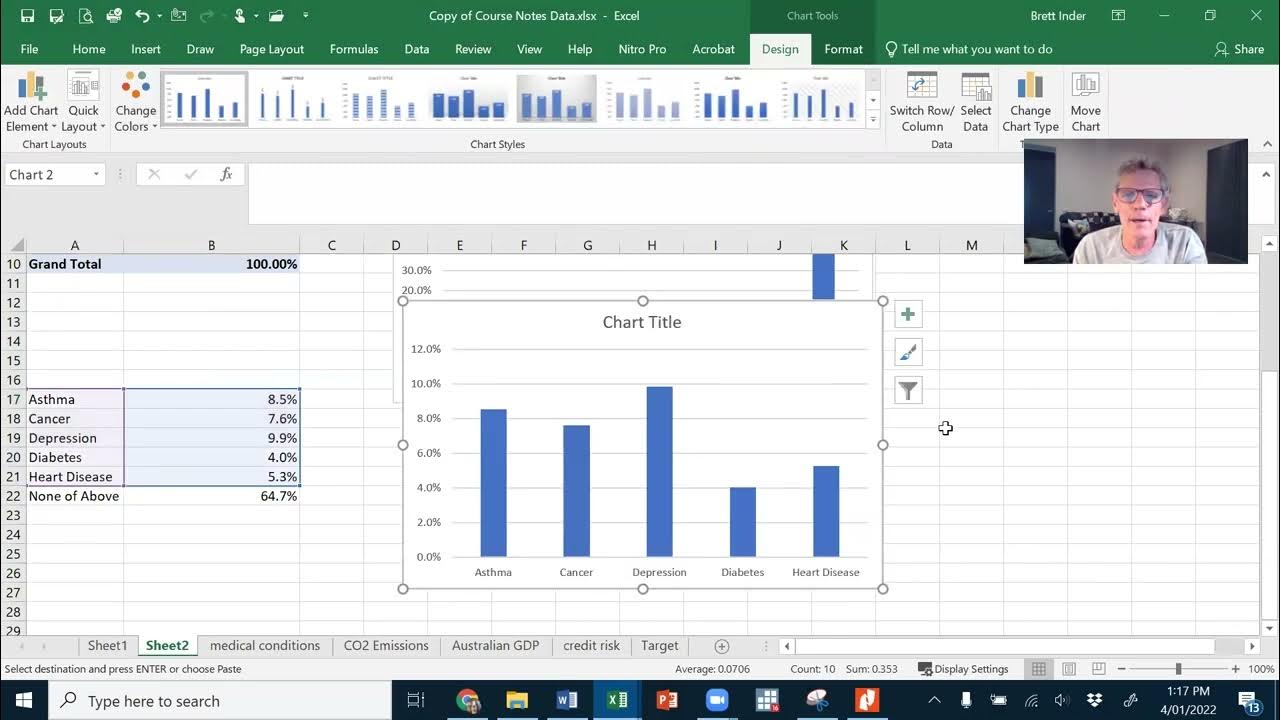Wiskundige Geletterdheid Gr 11 - Klassifikasie van data
Summary
TLDRThe video discusses the classification of data into different groups, focusing on categorical and quantitative data. It explains how categorical data can be divided into categories such as gender, race, and other traits. The video also introduces quantitative data, divided into discrete and continuous types, and illustrates how to distinguish between them. Discrete data involves countable elements, while continuous data includes values with decimal points. The video emphasizes using graphs to represent these data types, showing how to visually interpret patterns and relationships in both discrete and continuous datasets.
Takeaways
- 😀 Discussion on classifying data into different categories based on attributes.
- 📊 Categorical data examples include gender, race, and preferences like favorite drinks.
- 🎯 Clarification of medical data classification into discrete and continuous categories.
- 📈 Discrete data refers to countable values, like the number of people or specific numbers in a class.
- 💡 Continuous data refers to measurements that can take any value, like height or weight, often involving decimal points.
- 🔢 Explanation of how discrete data is represented on a graph with distinct points.
- 🌡 Continuous data examples include temperature and weight, represented with connected points on a graph.
- 📏 The difference between discrete and continuous data is highlighted with examples such as whole numbers versus decimals.
- 📉 Discussion on how continuous data can be plotted on a line graph, indicating fluid connections between points.
- 💬 Practice exercise mentioned for learners to distinguish between discrete and continuous data types.
Q & A
What is the main topic discussed in the script?
-The script discusses the classification of data into categories, specifically focusing on categorical and quantitative data, and how to distinguish between discrete and continuous data.
What are examples of categorical data mentioned in the script?
-Examples of categorical data mentioned include gender (male or female) and types of soft drinks (Coke or Sprite).
How is quantitative data classified according to the script?
-Quantitative data is classified into two types: discrete data and continuous data.
What is the difference between discrete and continuous data as explained in the script?
-Discrete data consists of countable numbers, such as the number of people in a class (1, 2, 3, etc.), while continuous data can take any value within a range, such as height or weight, often including decimal points.
What example of discrete data is given in the script?
-An example of discrete data given is the number of students in a class, which can be represented by whole numbers like 1, 2, or 3.
What example of continuous data is given in the script?
-An example of continuous data given is height, which can be measured with decimal points, such as 1.75 meters.
What role do decimal points play in distinguishing continuous data?
-Decimal points in continuous data indicate that the values can be measured more precisely and can take any value within a range, unlike discrete data which is limited to whole numbers.
What is a line graph used for in the context of continuous data?
-A line graph is used to represent continuous data, showing a smooth connection between points, implying that data points between values are possible.
What kind of data would you use to represent weight in kilograms?
-Weight in kilograms is considered continuous data, as it can be represented with decimal points, such as 30.5 kg.
What is the importance of distinguishing between discrete and continuous data?
-Distinguishing between discrete and continuous data is important for choosing the correct methods of data representation and analysis, as discrete data is countable while continuous data is measurable and can have infinite values within a range.
Outlines

Esta sección está disponible solo para usuarios con suscripción. Por favor, mejora tu plan para acceder a esta parte.
Mejorar ahoraMindmap

Esta sección está disponible solo para usuarios con suscripción. Por favor, mejora tu plan para acceder a esta parte.
Mejorar ahoraKeywords

Esta sección está disponible solo para usuarios con suscripción. Por favor, mejora tu plan para acceder a esta parte.
Mejorar ahoraHighlights

Esta sección está disponible solo para usuarios con suscripción. Por favor, mejora tu plan para acceder a esta parte.
Mejorar ahoraTranscripts

Esta sección está disponible solo para usuarios con suscripción. Por favor, mejora tu plan para acceder a esta parte.
Mejorar ahoraVer Más Videos Relacionados

What is Classification? What is a Classifier?

02 Klasifikasi data statistika

ETC1000 Topic 1a

Kurikulum Merdeka Materi Matematika Kelas 7 Bab 6 Data dan Diagram

CARA MEMBEDAKAN JENIS DATA NOMINAL, ORDINAL, INTERVAL, DAN RASIO | STATISTIKA PENELITIAN

SKALA PENGUKURAN KUISIONER : SKALA LIKERT, SKALA GUTTMAN, SEMANTIC DEFFERENSIAL, DAN RATING SCALE
5.0 / 5 (0 votes)
